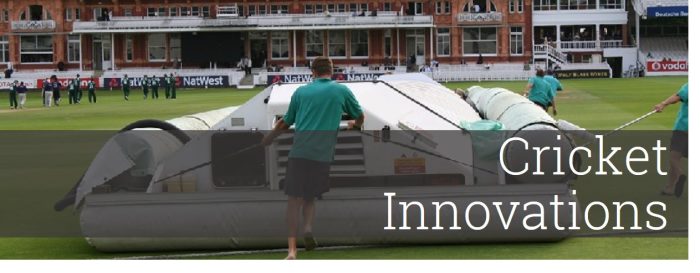Focus on Football
We have recently been busy installing a run of players tunnels for; Sheppey United, Accrington Stanley, Tranmere...

Originating in South-East England, Cricket marked its place as Britain’s National Sport in the 18th Century. The sport became popular around the world in the 19th and 20th Centuries. It is now thought to be the second most popular spectator sport in the world.
The sport has come a long way since the introduction of test cricket in 1877. Exceptional games, major wins and historic moments have emerged from every series. The general format and aim of the game has remained unchanged. However, the continuing success of the sport can be largely credited to the introduction of various cricket innovations.
From covers to equipment advancements and technological assisted umpiring. We’ve selected a few of our favourite, and most influential, cricket innovations from over the years.
One of the best cricket innovations to date is the introduction of pitch covers. When left exposed to adverse weather conditions, cricket pitches become damp and soft and can influence play. In order to strip out this factor pitch covers were introduced. This makes the job easier for groundsmen and batsmen alike. They are now used by cricket clubs all over the world to reduce the number of matches being cancelled. It also protects the ground from becoming vulnerable to damage in damp conditions.
Discover Stuart Canvas range of pitch covers here.
The Hover Cover was designed and patented by Stuart Canvas in 1998. The Hover Cover truly is an example of an excellent cricket innovation.
It has revolutionised the way in which major cricket grounds protect their pitches. Before the hover cover was created, rain would stop game play and the match couldn’t be resumed until pitch had completely dried out.
 The cover prevents this from happening by enabling staff to cover the pitch within three minutes with reduced manpower. It was installed at Lord’s in 2016 and is ideal for covering all Test Match and County grounds.
The cover prevents this from happening by enabling staff to cover the pitch within three minutes with reduced manpower. It was installed at Lord’s in 2016 and is ideal for covering all Test Match and County grounds.
Tony Dodemaide is the Head of Cricket at the Marylebone Cricket Club. He deemed the however cover “not only perfect for cricket –it makes good business sense too” following several rain interruptions during a test final.
There are many benefits of the Hover Cover, such as being more efficient and easier to use. In addition to this, it offers a potential revenue stream through sponsorship printing. Consequently, a number of leading clubs are using a Hover Cover, including Lords, Glamorgan, Edgbaston and Dakha.
Read more about Stuart Canvas Hover Cover here.
Changes in laws and ground conditions have demanded changes in the balls, and whilst the composition of the ball has remained pretty constant, the colours have changed. When it comes to day/night games, the debate over whether the ball should be red, white or pink is no longer rife.
The earliest kind of ball used in competitive cricket is the red ball. They tend to be used in day matches. They tend to be less popular in night or evening matches as when the yellow flood lights reflect off the red ball, the ball appears slightly brown and may be difficult to distinguish from the pitch.
White balls were first used in World Series Cricket. World Series Cricket were responsible for a lot of innovations in cricket, including coloured clothing and flood lighting. White balls were introduced for use in the evening or at night, under flood lights and is the colour generally used for one-day matches.
White balls are known to deteriorate rather quickly, so a pink ball maybe used to enable tests and first-class matches to be played at night. Whilst a white ball is more visible than a pink ball, a pink ball is more visible than a red ball and more durable than a white ball.
In 1992, a third umpire (also known as a TV umpire) was announced, situated off-field. The role allowed a final conclusion to be made regarding any close run-outs, stumpings and foul-play.
Acting as a kind of “third set of eyes” the third umpire is able to assist the on-pitch umpires. The third umpire bases his judgements through the player’s movements from a different angle, situation and perspective.
Years later, instant replay was introduced to assist in the umpire’s decision making. It was tested in 2008. The addition of game replay allowed more precision to the game as it can often be the factor which decides the matches winning team.
With all the progression the sport has made, how do we see cricket developing in the future?
Over the next ten years, experts are expecting that virtual reality will play a large part in training batsmen and bowlers, real-time communication between the coach and the team through the use of earpieces and wearable in-game technology.
We can’t wait to see how and when the nation’s most loved sport will develop and whilst we can’t say for certain the exact progression that will be made, we know for a fact that cricket is set to get bigger and better with every future match!
If you’ve enjoyed this brief trip through some of Crickets most influential cricket innovations, including Stuart Canvas’ Hover Cover we can recommend a trip to Lord’s Cricket Museum. The MCC Cricket Museum is amongst the oldest sporting museums in the world, with collections dating back to 1864.
You can head to the MCC’s website here to find out more.
Maintain a professional cricket field effortlessly with innovative tools. The Boundary Rope Reel Trolley by Stuart Canvas is the perfect solution for efficient boundary management, ensuring smooth operations on match days.
